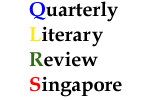 |
 |
|||||||||||||
|
By Jeremy Samuel
Gabriel's Gift
After his tender, semi-autobiographical study of modern relationships, Intimacy, Hanif Kureishi returns to comedy with Gabriel’s Gift. Unlike his first two novels, his latest offering does not feature, as its protagonist, an Asian teenager from Kent who moves to London in search of adventure, much as the author himself did. Gabriel Bunch is a schoolboy from North London, and white – a fact over-established through regular comments from the other characters along the lines of ‘He is blond, and not the wrong blond either!’
Apart from the element of race, the plot of Gabriel’s Gift follows roughly the same trajectory as the writer’s earlier work. A young lad, adrift in London and disappointed by his parents, finds salvation in artistic endeavour. Gabriel is a talented-but-struggling film-maker/painter in the tradition of the actor Karim Amir in The Buddha of Suburbia, or the writers Shahid Hasan in The Black Album and Jay in Intimacy.
Karim, in fact, makes a cameo appearance in Gabriel’s Gift, accompanied by his friend Charlie Hero ‘and two women’, in case we needed reassurance that Karim and Charlie’s homosexual relationship in Buddha was just an adolescent phase. From The Black Album, we get a reprise of the sexually voracious Deedee Osgood, now a therapist. These references would be puzzling to readers not familiar with Kureishi’s previous work, which makes it seem presumptuous of him to have included them, unless of course his intention was to confuse. The confusion occurs anyway, as a result of his integration of actual British culture with his novelised version of it, culminating in a party given by the fictional Jake Ambler but attended by real-and-still-alive celebrities (‘Oh God, look – now there’s Marianne Faithfull!’).
At the centre of this novel is a painting given to Gabriel by the pop star (and former colleague of his father’s) Lester Jones, helmsman of a splendidly titled seventies band: the Leather Pigs. This abstract creation is the ‘gift’ of the title, although the ‘gift’ also refers to Gabriel’s budding talent. Predictably, both Gabriel’s estranged parents vie for the piece of art, each ascribing a different value to it, and just as predictably, it ends up bringing them together through a series of adventures both inventive and intermittently touching.
Gabriel’s reflection, on looking at his picture, is that ‘it was busy; there was a lot in it, as there was in Lester’s music, with a memorable melody at the front that everyone could enjoy.’ This might be a description of the novel itself, which darts in all directions at once, taking in, en route, engaging vignettes such as Carlo, the dysfunctional celebrity brat ‘with a criminal grimace’. Above all this runs a feel-good plot which, in summary, could have come out of a contemporary children’s novel – a clever child reunites his divorced parents.
The Buddha of Suburbia featured a disjointed, ramshackle plot, which worked because of the furious energy propelling it along. This energy is still present in Gabriel’s Gift, but in a diluted, more meditative form. Gabriel’s ambition burns as brightly as Karim’s, but is given a bittersweet edge through its contrast with the failure his parents have made of their own lives. The frenetic seventies, in which they moved with famous people, somehow dried up and left them marooned in a London that fell apart around them as their dreams turned sour.
This novel operates in a dreamy, impressionistic vein, in contrast to the scabrous, picaresque nature of the earlier novels. Gabriel only has sex once in the course of the narrative (well, several times – but in a single session), which is positively restrained for a Kureishi character.
Perhaps trying to break new ground, Kureishi dabbles with a magic realism that faintly evokes Salman Rushdie (the climax of The Black Album, incidentally, involved a public burning of The Satanic Verses). The early surrealism – daffodils talk to Gabriel, the pictures he paints come to life – is not followed through however, and Kureishi eventually cops out by having Gabriel admit that all of this could be the product of hallucinations left over from his drug-taking days.
In the earlier novels, the protagonists turn to art because of an impulse to create; Gabriel is driven by a more bourgeois desire to express himself. This is a cue for Kureishi to explore the nature of artistic endeavour itself, which, unfortunately, involves characters saying things like ‘if you … read the greatest books, like Hamlet, you’ll see how weird, almost supernatural and dreamlike they are.’ None of this is particularly illuminating, and for all Gabriel’s alleged talent, his theories are equally drab.
Gabriel’s Gift is neither as enjoyable a read as Kureishi’s early novels, nor as emotionally gripping as the more recent Intimacy or Midnight All Day. It will probably not be one of the works Kureishi will be remembered for, but still manages, through its quirky humour and mordant observation, to hold the reader’s attention all the way to the improbably happy ending.
_____
|
|
|||||||||||||
Copyright © 2001 The Authors
Privacy Policy | Terms of Use |
E-mail